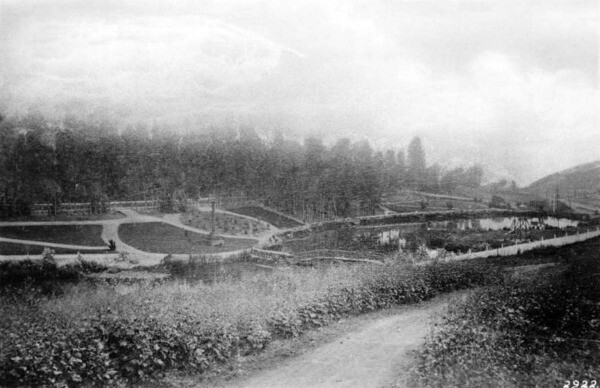How L.A. Lost One of Its Earliest Parks

This post continues a series looking at the origins of Los Angeles' oldest parks. Previous installments visited Westlake (MacArthur), Eastlake (Lincoln), and Prospect parks.
Many of the city's oldest parks have suffered deleterious changes through their history, but Los Angeles' Second Street Park boasts a dubious distinction: it's the only one that no longer exists. A popular outdoor retreat in the 1880s, the privately owned park became a casualty of industrial progress when L.A.'s first oil boom gripped the city in 1892. Today, not a trace of it remains.
Located at the present-day intersection of Glendale Boulevard and First and Second streets, the park was part of an ambitious plan to transform what had been a remote, inaccessible wilderness into the upscale residential district of Crown Hill. Built around 1885 by the Los Angeles Improvement Company -- the real estate syndicate behind the Crown Hill development -- the park would attract potential customers to the site, which could be reached from Los Angeles by the Second Street Cable Railway.
The park proved an immediate success. As buyers snapped up surrounding hillside lots, Angelenos flocked to the park for open-air dancing and strolls around the landscaped grounds.
Like Echo Park upstream, Second Street Park was nestled in the ravine of the Arroyo de los Reyes. A freshly planted grove of eucalyptus trees framed a small and (according to some accounts) naturally occurring pond. Amenities like a dance pavilion and playground equipment attracted group picnics. By the end of 1886, crowds had swelled to the point that the park's owners began charging a ten-cent admission fee on Sundays, its busiest day. The addition of a small zoo, which included thirty caged birds, five monkeys, a black bear, and an Angora goat, further added to the park's appeal.
But Second Street Park's most popular attraction was of the liquid kind. Sometimes referred to in the press as a beer garden, the park was stocked with kegs of lager, as well as wine, whiskey, and cigars. Watchful staff ensured that crowds would not grow too rowdy and spoil the park's family-friendly vibe. "Nothing disorderly is permitted to go on, and a policeman is never needed," the Los Angeles Times reported in 1888. "A keeper is always at the gate to refuse admittance to objectionable characters, and a plain drunk is led to the outside as soon as discovered."
For a few years, Second Street Park satisfied the city's appetite for outdoor experiences with controlled nature. But it soon fell on hard times as municipally owned sites like nearby Westlake Park opened to the public. A new owner, G.A. Friderich, purchased the site in 1891. To spur visitation, he renovated the park, adding electric lighting and rechristening it Lake Shore Park. Developments the following year, however, would render his efforts futile.
Parkgoers might have looked on with curiosity in November 1892, when across the street Edward L. Doheny and his associates opened the first free-flowing oil well in Los Angeles, but they likely did not appreciate the magnitude of Doheny's discovery nor its effect on the park. Within weeks, L.A.'s first oil boom was underway, and a forest of wooden derricks carpeted the neighborhood's once-treeless hills.
Second Street Park managed to coexist with the oil extraction industry for some time, but the noise and gases surrounding the once peaceful retreat eventually proved too much. The land -- still privately held -- also became too valuable to be reserved for parkgoers, and it passed into the hands of oil extractors.
When the oil boom waned and the derricks came down in 1906, drilling operations had erased the former park's footprint. The site reverted to raw real estate. Its new owners, a real estate syndicate led by Tyler & Co. and J. F. Jones, resolved to convert the former park into a residential development named Joseph Bayer's Lake Shore Tract. Hauling in 500 loads of dirt per day, the syndicate filled in the former lake bed, graded the tract, and sold it off in 53 individual pieces.






Many of the archives who contributed the above images are members of L.A. as Subject, an association of more than 230 libraries, museums, official archives, cultural institutions, and private collectors. Hosted by the USC Libraries, L.A. as Subject is dedicated to preserving and telling the sometimes-hidden stories and histories of the Los Angeles region. Our posts here provide a view into the archives of individuals and institutions whose collections inform the great narrative—in all its complex facets—of Southern California.